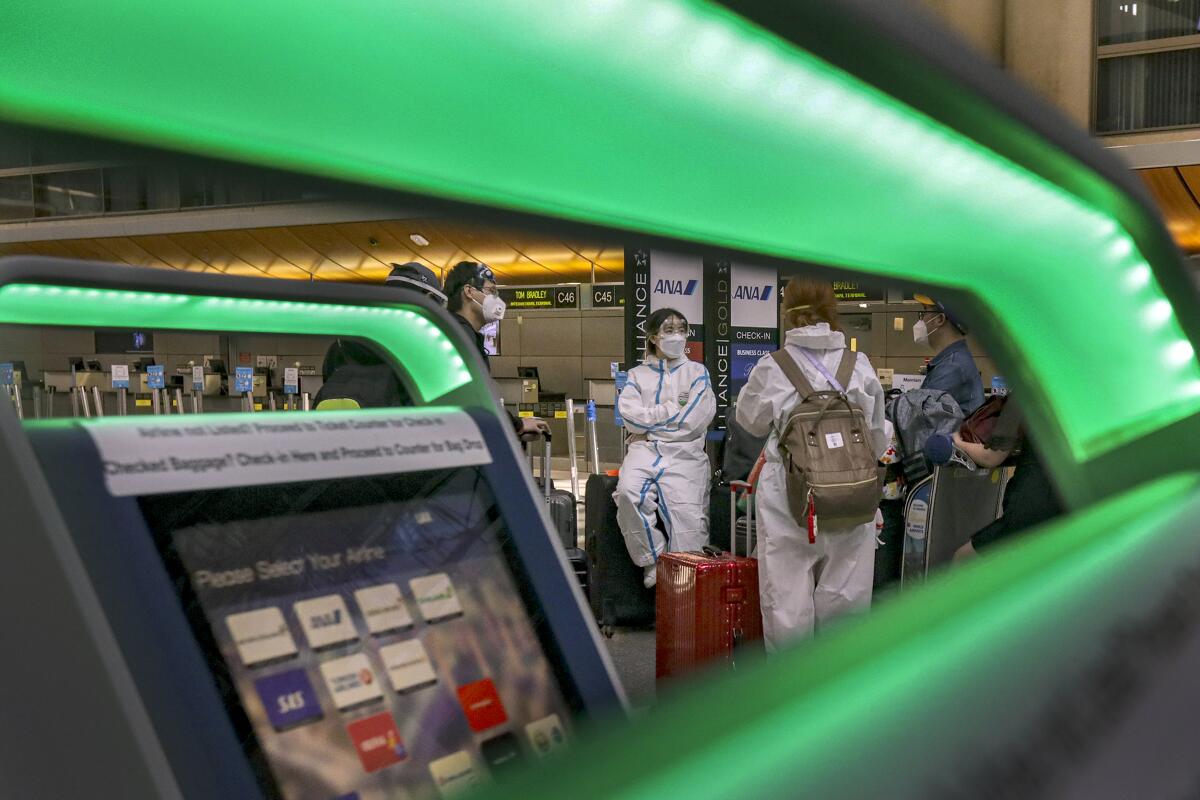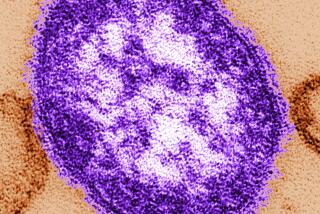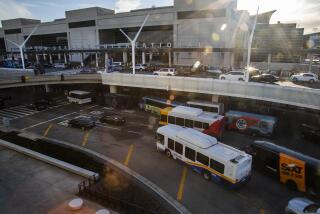More evidence emerges of the coronavirus slipping in through LAX

- Share via
After Long Beach physician Dr. Moira Rashid tested positive for COVID-19 in mid-March, she told contact tracers from the city health department that she had flown into Los Angeles International Airport from Munich, Germany, the day before falling ill.
Passengers and crew on the March 13 flight were not informed they had traveled with an infected person because Rashid was not displaying known symptoms of COVID-19 during the flight. Since then, the risk from asymptomatic people has become clear.
Rashid’s flight, Lufthansa 452, is the third instance identified by The Times in which public health officials in the early stage of the pandemic did not alert travelers into LAX that they were at risk for infection. Hundreds on these flights returned to their families and communities unaware they might be carrying the virus, potentially seeding new outbreaks.
L.A. County public health officials did not warn travelers or the public about early COVID cases at LAX, a Times investigation has found.
One passenger, a San Diego County man, died of COVID-19 three weeks after an Asiana Airlines flight from Seoul. His daughter said that until she read in The Times that a woman aboard his plane was stricken with the virus, “It was a mystery where he got it.”
“If we were informed by the airline or the CDC that he was on that flight that has that COVID-positive passenger, maybe we could have done [something] differently,” said his daughter, Myelene, who asked that their family be identified with first names only because of privacy concerns. Her father was given no instructions to self-quarantine, and doctors initially mistook his symptoms for minor ailments.
All three flights occurred in March before coronavirus cases mounted quickly in California. The infected woman on Myelene’s father’s March 8 flight, for example, became the first person to die of a confirmed case of the virus in Los Angeles County. The county Department of Public Health said at the time of the flights that employees were aggressively tracing each new case to control the virus’ spread.
Air travel, with people sharing close quarters for sustained periods, poses a heightened risk of transmission, and the Centers for Disease Control and Prevention has said it is crucial to track those exposed on planes and to move fast to prevent new cases.
In Rashid’s case, the job of tracking down those who had come in contact with her fell to officials in Long Beach, where she lived. She told investigators from the city’s Department of Health and Human Services that she had been on vacation in Egypt in early March and had taken a Nile cruise. A few days before her flight home, she lost her sense of smell and taste, developments that later became widely known as symptoms of COVID-19.
Unaware she was sick, she boarded the 12-hour Lufthansa flight. It was more than half full, she said, and she didn’t recall anyone wearing a mask.
“The day after our flight, I started coughing,” said Rashid, a family medicine doctor.
A March 16 test confirmed that she had the virus. The Long Beach health department’s policy in March was to contact individuals who had interacted with the infected person after the onset of symptoms. (Following new information from the CDC, the department expanded the tracing window in April to include the 48 hours before symptoms.)
Emily Holman, an epidemiologist and communicable disease controller for Long Beach, declined to speak about Rashid’s case specifically but noted that authorities didn’t recognize loss of taste and smell as COVID-19 symptoms at the time.
Based on the policy then, Rashid was not considered contagious until she began to cough the day after her flight.
Holman said Long Beach has notified the CDC of “dozens” of other flights carrying infectious passengers, adding, “We have them on speed dial.”
The other flights The Times found fell under the purview of the L.A. County Public Health Department. A passenger on a March 19 American Airlines flight from New York’s John F. Kennedy International Airport was hospitalized for COVID-19 a day after landing at LAX, but the department said it did not learn of the man’s positive test for 11 days and then closed the case when contact tracers couldn’t reach him for an interview.
The man triggered an outbreak in an assisted living facility. Ninety staff members and residents eventually got the virus and 13 people died, including a 32-year-old nurse.
The Asiana flight from Seoul on March 8 carried a 68-year-old woman who had symptoms before the trip and went into cardiac arrest the day after she landed at LAX. A driver who picked her up from the airport also died, according to her family. The county health department contacted the woman’s family to reconstruct her final interactions, and a tracer even asked for her flight number and seat assignment.
Still, no passengers or crew were contacted.
The county health department told The Times it notified a CDC office at LAX, but the CDC said it had no record of any report and the county did not produce documentation despite multiple requests from The Times.
Among the passengers who was not informed of possible exposure on the nearly 11-hour flight was Manuel, a 71-year-old retired civilian Navy worker returning from a monthlong visit to his native Philippines. From the airport, he went to the Chula Vista, Calif., home he shared with his close-knit extended family, where his grandchildren greeted him with hugs and hand-drawn “welcome back” signs, his daughter said.
Within a few days, Manuel had ear pain, a headache and a fever. In the emergency room at Sharp Chula Vista Medical Center, he was given a coronavirus test and told he would receive a call if it was positive. No one ever called, so he assumed he was in the clear, remembered Myelene, his daughter. A hospital spokeswoman declined to comment, citing patient privacy.
At the time, the family thought it unlikely he had the virus, his daughter said. None of the people he socialized with in the Philippines came down with it. In the days after the flight, he had left the house only twice for quick trips to the store.
But over the next 10 days, Manuel got increasingly sick. He developed a cough, lost his appetite and became confused. He went back to the emergency room March 22 and was put on a ventilator. He died of COVID-19 nine days later.
The pandemic’s toll: Lives lost in California
Hundreds of people have died in California due to the COVID-19 pandemic. These are some of their stories.
Manuel’s wife also tested positive for the virus but recovered.
“When my father died, I felt my one leg has been chopped,” said Myelene, who emigrated with her parents from the Philippines in 1996. For weeks, she thought she was about to lose her mother too.
Sarah Sweeney, a spokeswoman for the San Diego County Health and Human Services Agency, said it was impossible “to know what the impact of contact tracing on this flight would have been.”
“One would need far more detail than is currently available (such as the seat of the individual of the person who was reportedly symptomatic on the flight) in order to draw any educated conclusions,” Sweeney wrote in an email.
Months after Manuel’s death, the welcome-home signs still hang in the family’s house and his grandchildren struggle with the absence of the man they called “Lolo.”
“Every time I’m crying they approach me and say, ‘Mommy, don’t cry now. When Lolo gets better he will come back,’” Myelene said.
More to Read
Sign up for Essential California
The most important California stories and recommendations in your inbox every morning.
You may occasionally receive promotional content from the Los Angeles Times.











